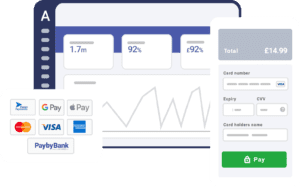In the world of payments, there’s a lot of technical jargon.
And this can make things difficult to follow if you’re not familiar with some of the phrases and terminology that’s being used to describe the steps and features that enable your payments process to function.
Without understanding these technical terms, it’s easy to end up confused and disengaged with the process, but that’s a situation that you’d rather avoid if possible.
If you’re an existing Acquired.com client, you’ll already have a great understanding of how our payments processing works and you’ll have access to our specialist team, who’ll be on hand to help you.
But we’ve put together this comprehensive payments glossary to help you out when you need a definition in an instant.
If you’re ever stuck looking for the meaning of a term or phrase that you encounter when chatting about our payments and solutions, this glossary is sure to be the perfect lifeline – you can keep our payments glossary to hand by saving this page or bookmarking it in your browser!
And if you’re currently looking for simple, effective, and intuitive payment solutions, be sure to get in touch with our expert team today.
Read on below to find our easy-to-digest definitions for all of the most important terms in the payments industry…
Account Updater
A service that enables merchants to update stored customer card details automatically.
If your business expects to handle recurring payments such as subscriptions, it’s important to ensure you can maintain the latest customer payment details to avoid declined payments.
An account updater solution helps to automatically keep customers’ payment details up to date by updating out of date information relating to lost, stolen, closed, or deactivated cards.
This means that you’ll see decreased instances of missed payments, securing your cash flow and maximising your recurring revenue streams.
Acquiring Bank (Acquirer)
The acquirer, also known as the merchant bank or acquiring bank, is the financial institution that is responsible for receiving card transaction details and passing these through to the card issuer via the card scheme for authorisation. An acquirer will either approve or decline transactions based on the information the card network and issuing bank hold about that card holder’s account. If the transaction is not authorised, the acquirer will tell you why.
All businesses that want to trade goods or services online, via app or in store will need an acquirer to process their payments.
Acquirers need to be licensed by the relevant card network and need to have the facilities and authorisation to process payments on the chosen card network.
Acquirer Reference Number (ARN)
When processing a transaction using a credit card, an Acquirer Reference Number (ARN) will be assigned to the transaction – this is a unique number used to identify the payment when it is sent from the merchant’s bank to the cardholder’s bank.
The ARN can also be used as a way to track a specific payment and make modifications such as a refund. Customers and merchants can both use this number when contacting their bank, giving more visibility on both sides of the transaction.
Application Programming Interface (API)
The term API is a shorthand abbreviation used to describe an Application Programming Interface. This is a widely used term that references the programming techniques used by software developers when they’re integrating services or applications into a process.
A payment API enables ecommerce businesses to more seamlessly manage payments. Payment APIs are able to optimise the payments process for both businesses and customers, making transactions faster and more secure.
For merchants, a major benefit of payment APIs is that they can help automate the payments process, reducing the time and resources are needed to maintain those systems. A payment API can be used to enable both one time and recurring payments.
Here at Acquired.com, we utilise the latest API technology. This means that your payments are protected and your services can be integrated with features such as client-side encryption, hosted payments pages, and so much more.
Authorisation
The authorisation process is relatively straightforward – a card issuer verifies the payment details and then reserves the funds to be captured later. Authorisation is an important factor when it comes to ecommerce in order to to mitigate risk and reduce fraudulent payments.
In these situations, an authorisation may be implemented in the form of an API request to the payment gateway.
This essentially means that the gateway and the payment processor will automatically trigger the required validation and risk checks needed to ensure that the details of the transaction match those held by the card network.
Once payment is authorised, the merchant can choose to capture the funds or decide to cancel the transaction – this may happen for out-of-stock orders, orders that don’t meet a minimum order value or payment for services outside the area of operation.
Authorisation will only be valid for a limited time, so the merchant must make their decision quickly, or the authorisation process may need to be triggered again.
Capture (or Clearing and settlement)
If a payment passes the necessary authorisation process, it can then be captured and, finally, completed. Capturing is the act of transferring the reserved funds for the transaction from the consumer’s account to the merchant’s.
With an AUTH_CAPTURE transaction type two functions are performed in a single request and payment will automatically be captured following authorisation – this gives a great degree of automation to the process, reducing the amount of work required by the merchant.
Most of the general payment methods also offer support for separated authorisation and capturing – this allows you to set up a process that gives you more control if you aren’t looking for total automation.
If preferred, you can do this in the form of a capture delay, manual payments capturing, partial captures, or even cancellation where required. As a collective, you may see actions such as captures, cancellations, or refunds referred to as ‘modifications’ – this is a widely used term in the payments industry and simply related to any actions that modify the state of an authorised payment request.
Cardholder
The cardholder is a vital part of the payment process – it’s the consumer who is using a bank-issued card to make a transaction to a merchant using a cashless payment method.
Cardholder Verification Method (CVM)
This is a type of verification that’s used to verify the payment instrument that’s been used in the transaction.
This will identify whether the payment was made using a debit card, credit card, store card, or any other method. At this stage, authentication will occur to ensure that the card is being used by the correct owner.
Card number (PAN)
Each card used for a payment, whether that’s debit, credit, gift, or something else entirely, will have a unique identification number assigned to it. You can find this number printed on the card and every transaction made using this card will be tied to this identification number.
The first part of this number (the first 6-8 digits), is used to identify the bank that issued the card and is called a Bank Identification Number (BIN), whilst the full number is called a Primary Account Number (PAN).
Alongside this unique identification number, you’ll also find a security code printed onto the card, which can help you to authorise transactions with ease. Every payment card (be it a debit, credit, gift, or similar card) has a unique number associated with it. This number is usually printed on the card and required to uniquely identify this card and to refer to it in every transaction.
Card on File (CoF)
Many merchants and payment processors will keep card details stored to enable fast, more efficient checkouts for future purchases.
Shoppers can opt-in or opt-out of this card detail storage, allowing them to choose the level of data that the merchant can keep concerning them. By choosing to store these details for future use, the shopper is creating a ‘Card on File’ – this is the default payment details assigned to this customer, enabling faster checkout through features such as one-click payments and recurring payments such as subscriptions, and more!
Chargeback and Disputes
From time to time, a consumer may want the funds for a purchase to be returned to them – this is called a ‘refund’.
In applicable cases, this refund request will be accepted by the merchant, usually in the form of a returns process, and the return of the funds is fairly straightforward. However, there are instances where the merchant may decline the requests for a refund – in these situations, consumers can choose to ask their card issuer for a ‘chargeback’.
A chargeback is a mechanism for the customers card provider to reclaim money from the merchant’s bank. When a chargeback is initiated, the merchant still can dispute the request if the circumstances allow it.
Merchants will be required to provide some documents to the acquiring bank and payment processor at this stage. These documents will need to display proof of delivery for the product, or else the disputed chargeback could be rejected and the funds will be returned.
At Acquired.com, we’re committed to making the chargeback and refunds process as simple as possible for our merchants. We’ll automatically dispute chargebacks and conduct a thorough risk assessment and management to ensure that you’re not the victim of a fraudulent transaction or unwarranted chargeback.
Contactless or Near Field Communication (NFC)
Contactless payment is a way for shoppers to pay for goods or services without having to insert their card into the card reader.
This works through the use of NFC, or near field communication, and can be found in multiple forms such as contactless cards, Apple Pay, Google Pay, and other similar tools.
These payments are deemed to be very strong when it comes to customer authentication. This is primarily due to the features implemented in smartphone wallet applications, where biometrics data including fingerprint and face ID, or passcodes are needed to process a payment.
Fraud
Fraud is one of the major problems that merchants face regularly, with customers trying to take advantage of the returns and chargeback processes to receive funds that they are not entitled to.
If a fraud attempt is made, you could be in danger of losing money if you don’t have the correct processes in place to assess risk and react to suspicious activity. Both merchants and consumers can be the victim of fraud, but in most instances, it will be the merchant that is targeted due to the increased chance of high-value refunds/chargebacks.
With Acquired’s payment solutions, we’ll implement an extensive AML procedure to ensure that your money is protected from fraudsters around the clock.
Issuing bank
Bank cards must be issued by a validated bank to be fit for use for cashless payments. The issuing bank is the entity responsible for issuing these cards to the shopper.
Once issued, the card can be integrated into contactless applications such as Apple Pay or Google Pay, but in the first instance, it will be a physical plastic card that you receive.
The issuing bank will need to be a member card network to be able to subscribe a card to a consumer. Many issuing banks are members of multiple card networks, allowing them to issue different types of cards to their customers based on their needs or preferences.
Know Your Customer (KYC)
Know Your Customer is a set of protocols that are deployed to strengthen the identification and validation process for customers.
In the payments sector, a rigorous KYC process is required by the industry guidelines – this is to protect both the merchant and the shopper for the duration of their transaction.
With Acquired.com, you won’t need to worry about carrying out your KYC checks – we’ll monitor your new and existing customers, ensuring that all KYC data is collected promptly so that verification can be confirmed as soon as possible.
Marketplace
A marketplace is a website or application that functions as an eCommerce tool. Merchants will be able to provide customers with quick and easy access to their range of products, all tied together with a handy checkout process, streamlining the journey and improving the user experience with the seller.
Merchant
The merchant is the entity that is selling its goods or services to the shopper in any transaction.
The merchant can operate via an eCommerce platform, mobile application, or point of sale entity, giving shoppers multiple ways to access their products or services. Merchants should to be able to accept and process payments made by their customers through a variety of mediums including credit and debit card payments, online payments, and through digital wallets.
Modifications
Once payment is authorised, the merchant has two options: capture the payment or cancel it. As these actions are taken after authorisation, this is deemed to be a ‘modification’.
With Acquired.com, modifications can be made both manually and automatically, depending on how you’d prefer to manage this process. If this is managed automatically, an API will be used to acknowledge that the modification has been actioned.
Notifications
The Acquired server sends HTTP callbacks (webhooks) to the merchant server. They alert merchants of authorised, captured, and amended payments, among other occurrences.
Notifications (also known as Instant Payment Notifications or IPN) are an important aspect of the Acquired.com integration process. Merchants use them to guarantee that they have completed all payment phases and have stored payment results in their database.
One-click payments
One-click payments make it much easier for return customers to make payments without having to enter their payment details every time they make a purchase.
Operating using the Card on File process, users will be able to store their contact details on your eCommerce website, and then use these same details the next time that they choose to shop on your site.
This makes the shopping process much more enjoyable for users and encourages them to make their payments promptly, removing any potential barriers that may stop them from making their purchases.
When a customer enables one-click payments, their card details and billing address are stored by your website after the first payment. They will then be presented to the customer the next time they use your site, so they can confirm that these details are still correct before they confirm the purchase.
The only detail that the customer will be prompted to input into the site when purchasing will be their card security code.
Once-click payments are just as secure as a traditional input payment – they’ll carry out a full card authorisation process and will conduct security checks and 3D Secure if required.
Payment gateway
A payment gateway is a service that helps merchants to initiate payments online, in applications, or even in person at a store.
In general, this will be in the form of a web server that’s connected to the merchant’s website or POS system. If the merchant doesn’t have a payment gateway, they won’t be able to receive payment from their customers.
At Acquired.com, we combine the functions of a payment gateway and a payment processor, giving us greater insights into your payments process as a holistic end-to-end journey. In doing this, we can keep a closer eye on risk management and potential fraud that could place your business in danger. With Acquired.com, all of your payment needs are taken care – providing you with a streamlined payments ecosystem.
Payment processor
A payment processor is a company that’s connected to both the merchant and the consumer’s bank and is used to make a payment transaction, essentially a payment processor manages the card transaction process.
A payment processor will communicate the payment information for the transaction by using a payment gateway and pass the information from the customer’s card to the merchant’s bank and the customer’s bank. Assuming there are sufficient funds in the customers account, the transaction will go through.
Payment Service Provider (PSP)
Payment service providers are businesses that operate as both a payment gateway and a payment processor, connecting the different parts of the payment experience into one efficient process.
In addition to this, a PSP can also provide additional financial services, helping you to combine your different processes and control them through one simple third-party source.
Utilising a PSP can be much cheaper for merchants, as you’ll be able to pay one set fee for your services rather than different fees to different providers for the same suite of services.
Acquired.com provides clients with an omnichannel approach that tackles financial services and payments effectively, whilst considering costs and keeping things affordable for merchants. Get in touch with our team to discuss how we can help you to maximise efficiency when initiating, validating, and completing payments.
Payment terminal
A payment terminal is a device that communicates with the shopper’s card or device to initiate a payment at the point of sale.
This can be through traditional methods such as swipe or insert, or modern NFC-enabled actions such as contactless cards or applications such as Samsung Pay, Google Pay, and Apple Pay on mobile phones, smartwatches, and other digital devices.
Depending on the type of card that’s used, the user may be asked to verify their identity through the use of a PIN or face/fingerprint ID when using mobile devices. This acts as a further layer of security that ensures only the owner of the card can perform transactions using the card. The terminal will receive an API request when the shopper attempts to make a payment using their card. When the terminal accepts this request, the transaction process starts.
The total amount payable is displayed on a screen and then the shopper can accept this amount and proceed to make their payment. If required, a receipt of the transaction can be produced at this stage.
Recurring payments
For some merchants, recurring payments and subscriptions are the most fundamental type of payments that they need to be able to process. These are regular, consistent payments that happen on a scheduled basis, such as media subscriptions or food subscriptions.
Acquired.com can securely retain payment details to facilitate recurring payments as a PCI-compliant payment processor. In response, the merchant receives a token that is unique to a certain customer and their payment information. To enable this, the customer must consent to this recurring contract during the initial authentication process.
A merchant can utilise this token in the future if recurring payments are enabled. Every time a shopper is charged for a subscription, initiates a card-on-file payment, or initiates an unscheduled card-on-file payment, the merchant passes the token along with the authorisation call. This speeds up the transaction process and keeps the customer journey moving at the desired pace.
As cards expire or are cancelled, stored card details become out of date. To combat this, you can use Acquired.com’s Account Updater service to guarantee that you have the most up-to-date card information, allowing you to deliver uninterrupted subscription services.
Refund
From time to time, a customer may cancel a purchase or a subscription – in these situations, the customer will require the funds for the purchase to be returned to them, which is known as a refund.
If the payment has not yet been captured, this process is much easier – the merchant can cancel the payment and the funds are simply returned to the shopper’s account. If the funds have already been captured, a refund is still possible but it may take some more time to process this.
If a merchant disputes a refund request, a shopper may make a chargeback request – you can learn more about this in our ‘Chargebacks’ definition in this glossary!
Scheme fee
A fee that is paid to the card scheme by the acquirer for each payment transaction done with the card scheme. In addition to the interchange cost, the fee amount is defined by the corresponding card system – these fees differ slightly between systems, which is something to be aware of before engaging with a certain scheme.
Subscriptions
Subscriptions are payments that are made regularly. Music and TV streaming services are popular examples of subscription charges, as are cosmetics boxes and magazine deliveries.
Tokenisation
Tokenisation is the process of replacing a customers card details with a series of randomly-generated numbers known as a ‘token’. These tokens can then be securely passed through the networks needed to process a payment without the customers actual bank details being exposed.
Transaction (or Tx)
The term “transaction” in the payments industry refers to the exchange of a set quantity of currency from a shopper for the purchase of goods or services from a merchant, or for the fulfilment of any other responsibilities between the two parties.
During a transaction, funds are usually transferred using card payments, such as debit cards and credit cards, or local payments such as bank transfers and mobile payments. The abbreviation ‘Tx’ is used to denote a transaction in formal records.
Zero-value auth
A zero-value authorisation is a form of authentication where a request is made in the amount of 0 (zero) to gather shopper details so that previous purchases and specific details can be found in the merchant database. A zero value authorisation enables a merchant to request a customer’s tokenised card number without presenting the transaction for authorisation.
Streamline your payments process with Acquired.com
At Acquired.com, we’re experts when it comes to payments.
We want to provide our merchants with the best payment experience possible, with the ability to receive payments, process refunds, easily dispute chargebacks, and automatically update customer card details with ease.
That’s why we’re constantly evolving our platform, looking to utilise the latest technology to improve our service and keep your business ahead of the curve at every stage.
For merchants, this creates an optimal operating environment that takes the stress of payments away, helping you to focus on providing the highest quality products and services to your customers.
If you’d like to learn more about how Acquired.com can help to elevate your payments operations, get in touch with a member of our expert team today!













